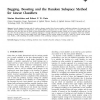Free Online Productivity Tools
i2Speak
i2Symbol
i2OCR
iTex2Img
iWeb2Print
iWeb2Shot
i2Type
iPdf2Split
iPdf2Merge
i2Bopomofo
i2Arabic
i2Style
i2Image
i2PDF
iLatex2Rtf
Sci2ools
PAA
2002
2002
Bagging, Boosting and the Random Subspace Method for Linear Classifiers
: Recently bagging, boosting and the random subspace method have become popular combining techniques for improving weak classifiers. These techniques are designed for, and usually applied to, decision trees. In this paper, in contrast to a common opinion, we demonstrate that they may also be useful in linear discriminant analysis. Simulation studies, carried out for several artificial and real data sets, show that the performance of the combining techniques is strongly affected by the small sample size properties of the base classifier: boosting is useful for large training sample sizes, while bagging and the random subspace method are useful for critical training sample sizes. Finally, a table describing the possible usefulness of the combining techniques for linear classifiers is presented.
Distributed And Parallel Computing | Linear Discriminant Analysis | PAA 2002 | Random Subspace Method | Training Sample |
Related Content
| Added | 23 Dec 2010 |
| Updated | 23 Dec 2010 |
| Type | Journal |
| Year | 2002 |
| Where | PAA |
| Authors | Marina Skurichina, Robert P. W. Duin |
Comments (0)

